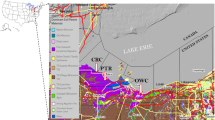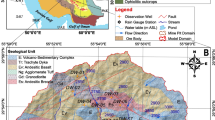Abstract
Characterization of geologic heterogeneity is crucial for reliable and cost-effective subsurface management operations, especially in problems that involve complex physics such as deep aquifer storage of carbon dioxide. With recent advances in computational power and sensor technology, large-scale aquifer characterization using various types of measurements has been a promising approach to achieve high-resolution subsurface images. However, large-scale inversion requires high, often prohibitive, computational costs associated with a number of large-scale coupled numerical simulation runs and large dense matrix multiplications. As a result, traditional inversion techniques have limited utility for problems that require fine discretization of large domains and a large number of measurements to capture small-scale heterogeneity, like \(\text {CO}_2\) monitoring in the subsurface. In this work, we apply the principal component geostatistical approach (PCGA), an efficient inversion method, for large-scale aquifer characterization. The domain considered is a synthetic three-dimensional deep saline aquifer intended for \(\text {CO}_2\) storage with 24,000 unknown permeability grid blocks. Transient pressure and heat tracer measurements from multiple dipole pumping tests are simulated with the TOUGH2 simulator and are used to estimate the heterogeneous permeability field and the corresponding uncertainty. For this scenario, we investigate the worth of combining heat and pumping tracer data for characterization. We demonstrate that with the PCGA, the inversion can be performed at a reasonable computational cost, while also resolving the main features of the permeability field. This presents opportunities for using inverse modeling to improve monitoring design and data collection strategies in field applications.







Similar content being viewed by others
References
Brown, P.N., Saad, Y.: Hybrid Krylov methods for nonlinear-systems of equations. SIAM J. Sci. Stat. Comput. 11(3), 450–481 (1990)
Carle, S.F., Fogg, G.E.: Modeling spatial variability with one and multidimensional continuous-lag Markov chains. Math. Geol. 29(7), 891–918 (1997)
Carrera, J., Alcolea, A., Medina, A., Hidalgo, J., Slooten, L.J.: Inverse problem in hydrogeology. Hydrogeol. J. 13(1), 206–222 (2005)
Cirpka, O.A., Kitanidis, P.K.: Sensitivity of temporal moments calculated by the adjoint-state method and joint inversing of head and tracer data. Adv. Water Resour. 24(1), 89–103 (2000)
Daley, T.M., Solbau, R.D., Ajo-Franklin, J.B., Benson, S.M.: Continuous active-source seismic monitoring of CO2 injection in a brine aquifer. Geophysics 72(5), A57–A61 (2007)
Doro, K.O., Cirpka, O.A., Leven, C.: Tracer tomography: design concepts and field experiments using heat as a tracer. Groundwater 53, 139–148 (2015)
Doughty, C., Pruess, K.: Modeling supercritical carbon dioxide injection in heterogeneous porous media. Vadose Zone J. 3(3), 837–847 (2004)
Fakhreddine, S., Lee, J., Kitanidis, P.K., Fendorf, S., Rolle, M.: Imaging geochemical heterogeneities using inverse reactive transport modeling: an example relevant for characterizing arsenic mobilization and distribution. Adv. Water Resour. 88, 186–197 (2016)
Jiang, Y., Woodbury, A.D.: A full-Bayesian approach to the inverse problem for steady-state groundwater flow and heat transport. Geophys. J. Int. 167(3), 1501–1512 (2006)
Kang, P.K., Lee, J., Fu, X., Lee, S., Kitanidis, P.K., Juanes, R.: Improved characterization of heterogeneous permeability in saline aquifers from transient pressure data during freshwater injection. Water Resour. Res. 53(5), 4444–4458 (2017)
Kitanidis, P.K.: Orthonormal residuals in geostatistics—model criticism and parameter-estimation. Math. Geol. 23(5), 741–758 (1991). doi:10.1007/Bf02082534
Kitanidis, P.K.: Quasi-linear geostatistical theory for inversing. Water Resour. Res. 31(10), 2411–2419 (1995)
Kitanidis, P.K.: Bayesian and Geostatistical Approaches to Inverse Problems, pp. 71–85. Wiley, Hoboken (2010)
Lee, J., Kitanidis, P.K.: Large-scale hydraulic tomography and joint inversion of head and tracer data using the principal component geostatistical approach (PCGA). Water Resour. Res. 50(7), 5410–5427 (2014)
Lee, J., Yoon, H., Kitandis, P.K., Werth, C.J., Valocchi, A.J.: Scalable subsurface inverse modeling for a big data set with an application to massive magnetic resonance imaging tracer concentration data inversion. Water Resour. Res. 52(7), 5213–5231 (2016)
McLaughlin, D., Townley, L.R.: A reassessment of the groundwater inverse problem. Water Resour. Res. 32(5), 1131–1161 (1996)
Nowak, W., Cirpka, O.A.: Geostatistical inference of hydraulic conductivity and dispersivities from hydraulic heads and tracer data. Water Resour. Res. 42(8), W08416 (2006)
Oliver, D.S., Reynolds, A.C., Liu, N.: Inverse Theory for Petroleum Reservoir Characterization and History Matching. Cambridge University Press, Cambridge (2008)
Schwede, R.L., Li, W., Leven, C., Cirpka, O.A.: Three-dimensional geostatistical inversion of synthetic tomographic pumping and heat-tracer tests in a nested-cell setup. Adv. Water Resour. 63, 77–90 (2014)
Somogyvári, M., Bayer, P., Brauchler, R.: Travel-time-based thermal tracer tomography. Hydrol. Earth Syst. Sci. 20(5), 1885–1901 (2016)
Straface, S., Chidichimo, F., Rizzo, E., Riva, M., Barrash, W., Revil, A., Cardiff, M., Guadagnini, A.: Joint inversion of steady-state hydrologic and self-potential data for 3D hydraulic conductivity distribution at the Boise Hydrogeophysical Research Site. J. Hydrol. 407(14), 115–128 (2011)
Acknowledgements
The research was funded by the National Science Foundation through its ReNUWIt Engineering Research Center (www.renuwit.org; NSF EEC-1028968). The authors also acknowledge the support of the National Science Foundation through its ReNUWIt Engineering Research Center (www.renuwit.org; NSF EEC-1028968) and the Army High Performance Computing Research Center (AHPCRC, sponsored by the U.S. Army Research Laboratory under Contract No. W911NF-07-2-0027) at Stanford University. JL was supported in part by an appointment to the Postgraduate Research Participation Program at the U.S. Army Engineer Research and Development Center, Coastal and Hydraulics Laboratory (ERDC-CHL) administered by the Oak Ridge Institute for Science and Education through an interagency agreement between the U.S. Department of Energy and ERDC. We would like to thank Dr. Quanlin Zhou of Lawrence Berkeley National Laboratory for support on TOUGH2. We also thank Dr. Alberto Guadagnini and an anonymous reviewer for the insightful comments to improve the paper.
Author information
Authors and Affiliations
Corresponding author
Rights and permissions
About this article
Cite this article
Lee, J., Kokkinaki, A. & Kitanidis, P.K. Fast Large-Scale Joint Inversion for Deep Aquifer Characterization Using Pressure and Heat Tracer Measurements. Transp Porous Med 123, 533–543 (2018). https://doi.org/10.1007/s11242-017-0924-y
Received:
Accepted:
Published:
Issue Date:
DOI: https://doi.org/10.1007/s11242-017-0924-y




